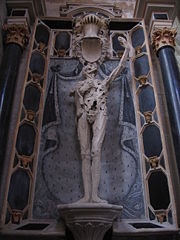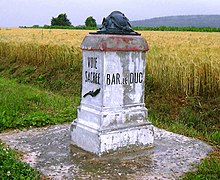Bar-le-Duc
| Bar-le-Duc | ||
|---|---|---|

|
|
|
| region | Grand Est | |
| Department | Meuse ( prefecture ) | |
| Arrondissement | Bar-le-Duc | |
| Canton |
Bar-le-Duc-1 (main town) Bar-le-Duc-2 (main town) |
|
| Community association | Bar-le-Duc Sud Meuse | |
| Coordinates | 48 ° 46 ' N , 5 ° 10' E | |
| height | 175–327 m | |
| surface | 23.62 km 2 | |
| Residents | 14,985 (January 1, 2017) | |
| Population density | 634 inhabitants / km 2 | |
| Post Code | 55000 | |
| INSEE code | 55029 | |
| Website | http://www.barleduc.fr/ | |
 The Ornain in Bar-le-Duc |
||
Bar-le-Duc is a town in north-eastern France with 14,985 inhabitants (as of January 1, 2017) in the Meuse department in the Grand Est region (until 2015 Lorraine ).
geography
The city extends over an area of 23.62 square kilometers, lies within a narrow valley and is surrounded by forests and vineyards. It is located on the Ornain , over which numerous bridges lead. It is located on the railway line to Paris and is also accessed by the Canal de la Marne au Rhin (German: "Rhine-Marne Canal"), which enables a navigable connection from the Paris area to the Rhine using other canals .
history
The origin of the city goes back to a Gallo-Roman settlement. In the Merovingian period a "Burgum Barri" was called as the main place of the pagus Barrensis . In 954 Bar was the seat of the Count of Bar and belonged to the Holy Roman Empire . In 1243 Bar-le-Duc received city rights.
1301 Count of Bar had its west of the Maas lying possessions to the French king, who was standing on the side of his opponents to feud apply; these parts of the county were then called Barrois mouvant ( mouvant du roi de France = feudal touch from the King of France). In 1354 the county of Bar was raised to a duchy . The Duchy of Bar fell to the Duchy of Lorraine in 1485 and to France in 1766 .
A historical view of the city of Bar-le-Duc comes from Matthäus Merian the Elder.
After the French Revolution (1789–1799), the city became the capital of the Meuse department and was called Bar-sur-Ornain from 1792 to 1815 .
During the First World War (1914-1918) the road from Bar-le-Duc to Verdun was of great importance for the French army. In 1916 it was the only remaining connection to Verdun during the Battle of Verdun. All supplies went through this street. It has since been referred to as the Voie Sacrée .
Population development
| year | 1962 | 1968 | 1975 | 1982 | 1990 | 1999 | 2007 | 2014 |
| Residents | 18,346 | 19,159 | 19,288 | 18,471 | 17,545 | 16,944 | 16.002 | 15,668 |
Town twinning
The city of Bar-le-Duc maintains city partnerships with the German cities of Wilkau-Haßlau , south of Zwickau in Saxony, and with Griesheim , near Darmstadt. There is also a partnership with the Hungarian city of Gyönk .
Attractions

The city is a testament to the Renaissance architecture. It contains two historically interesting parts: the lower town on the Ornain river and the upper town on the mountainside. In the lower town, the Notre-Dame church from the 12th century, the Notre-Dame bridge and the building of the Collège Gille de Trêves (1571) are worth seeing .
Many stone houses from the 15th, 16th and 17th centuries have been preserved in the upper town. The castle of the Dukes of Bar was largely demolished in 1670 . The area is now a large square, decorated with flower beds, trees and benches. Right next to it is the museum ( Musée Barrois ) in a building from the 16th century. The church of Saint-Étienne (15th century) contains the famous statue by the sculptor Ligier Richier (approx. 1500–1567) called Le Transi or the skeleton . A Transi , like a Gisant, is a lying grave sculpture. In contrast to the Gisant, the deceased is shown in a state of decay.
More Attractions:
- Parish church of Saint-Antoine , built as a monastery church, 14th century
- Town hall, erected as a representative residential building, classicistic, 1803/1813
- Marbeaumont Castle , built as a representative residential building of a banker, eclectic, 1903/04
- Clock tower, the only remnant of the medieval fortifications that surrounded today's castle , executed in humpback blocks , the westernmost occurrence of Staufer castle architecture in Lorraine
- Hotel de Florainville
- Hotel de la Bessière
- Hotel de l'Escale
- Hotel de Marne
- Hotel de Radouan
- Hotel de Salm
- Rue des Ducs , La Place Saint-Pierre
- Synagogue , built 1870/71 (Monument historique)
- the monument to Pierre and Ernest Michaux commemorates the inventors of the velocipede
Culinary specialties
- La Duchesse , transparent currant jam, whose berries are seeded with a goose quill as caviar bar called
- Le Ducale and Le Renaissance , chocolate specialties
- Currant and rhubarb wines
- Beers from microbreweries
Personalities
- Anton the Good (1489–1544), Duke of Lorraine
- Marie de Guise (1515–1560), the second wife of the widowed Jacob V, Queen of Scotland and mother of Maria Stuart
- François de Lorraine, duc de Guise (1519–1563), general and statesman
- Nicolas de Lorraine, duc de Mercœur (1524–1577), Duke of Mercœur
- Jean Errard de Bar-le-Duc (1554–1610), father of French fortification architecture
- Jean Leurechon (1591–1670), mathematician and Jesuit
- Jean-Henri d'Anglebert (1629–1691), composer, harpsichordist and organist
- Karl von Lothringen-Commercy (1661–1702), Imperial Field Marshal
- Pierre Parisot (1703–1769), missionary, priest of the Capuchin Order
- Nicolas-Charles Oudinot (1767–1847), Marshal of France
- Rémy-Isidore Exelmans (1775–1852), Marshal of France
- Pierre-Charles Robert (Bar-le-Duc 1812–1887 Paris), numismatist
- Edmond Laguerre (1834-1886), mathematician
- Jules Develle (1845–1919), politician during the Third Republic
- Raymond Poincaré (1860–1934), statesman and politician
- Pierre de Bréville (1861–1949), composer
- Jules-Henri Desfourneaux (1877–1951), executioner
- Gustave Lefebvre (1879–1957), Egyptologist and classical philologist
- Marcel Ulrich (1880–1933), engineer and politician
- Ernest Wickersheimer (1880–1965), doctor, medical historian and librarian
- Magali Faure (* 1972), track cyclist
- Benjamin Compaoré (* 1987), athlete
literature
- Le Patrimoine des Communes de la Meuse. Flohic Editions, Volume 1, Paris 1999, ISBN 2-84234-074-4 , pp. 71-128.
- Karl Ferdinand Werner : Bar (-le-Duc), battle at . In: Lexicon of the Middle Ages (LexMA). Volume 1, Artemis & Winkler, Munich / Zurich 1980, ISBN 3-7608-8901-8 , Sp. 1429 f.
Web links
- Website of the city of Bar-le-Duc (French)
Individual evidence
- ^ Guides Gallimard (ed.): Lorraine . Gallimard, Paris 2002, ISBN 978-2-7424-0908-2 , pp. 66 . (French)



